Criminal justice social work statistics: 2017-2018
2017-2018 statistics on various areas of criminal justice social work in Scotland.
5.1 Social work orders
5.1.1 Total social work orders for the years 2015-16 to 2017-18 include community payback, drug treatment & testing and fiscal work orders. Community payback orders replaced community service, probation and supervised attendance orders (the latter three referred to as ‘legacy’ orders in this report) for offences committed from February 2011 onwards. Due to the low numbers involved, the number of legacy orders commenced was not collected for these most recent three years. Fiscal work orders were introduced nationally on 1 April 2015 and have therefore been collected since 2015-16. As a result of these changes in order types, caution should be exercised when comparing total social work orders in the most recent three years with totals from previous years.
5.1.2 There were 19,400 social work orders commenced in 2017-18 (Table 2), a fall of six per cent on 2016-17. The vast majority (92 per cent) of social work orders in 2017-18 were community payback orders. Local authority level breakdowns for each of these individual order types are available in the additional datasets which accompany this publication.
5.1.3 In total, 74 per cent of orders commencing in 2017-18 (around 14,300) included an element of unpaid work or other activity. This comprises 1,000 fiscal work orders (Table 2) and 13,300 community payback orders with unpaid work or other activity requirements (Table 12).
5.1.4 Seventy per cent of social work order terminations in 2017-18 resulted in completion or discharge (Table 2). With the exception of the high in 2013-14, this proportion has remained stable over the last seven years. The completion rates in 2017-18 varied substantially between different types of order. The highest was for fiscal work orders (86 per cent) and the lowest for the higher tariff drug treatment and testing orders (40 per cent), reflecting the challenges facing the latter client group. The completion rate for community payback orders was also 70 per cent in 2017-18, around the same as in recent years.
5.2 Community payback orders
(Tables 2 & 10-24 and Charts 3-7)
5.2.1 The number of community payback orders (CPOs) imposed increased in the first few years following their introduction, from 10,200 in 2011-12 to 18,700 in 2013-14 (Table 2). This rise was expected due to CPOs replacing legacy orders for offences committed on or after 1 February 2011. The total CPOs imposed remained stable at around 19,000 in each of the years 2013-14 to 2016-17, but fell by seven per cent in 2017-18 to 17,800.
5.2.2 In 2017-18, there were 46 CPOs imposed per 10,000 population (Table 3 & Chart 3). This was highest for those living in East Ayrshire (74), North Ayrshire (72) and West Dunbartonshire (67) and lowest for those living in East Renfrewshire (20), East Lothian (23) and Na h-Eileanan Siar (24). The proportion was higher than in Scotland as a whole for residents of the Glasgow (59), Aberdeen (67) and Dundee (55) city areas but considerably lower for City of Edinburgh residents (24). More detailed information by local authority area can be found in the additional datasets which accompany this publication
Chart 3: Number of community payback orders imposed per 10,000 population: Breakdown by local authority area, 2017-18
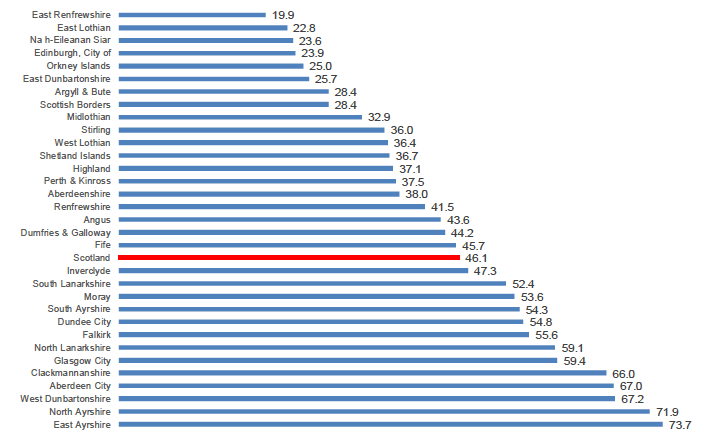
Note: Population aged 16 to 70.
Requirements
5.2.3 A CPO can have up to nine different requirements but every order should have either or both an unpaid work or other activity requirement or an offender supervision requirement.
5.2.4 Unpaid work or other activity has always been the requirement most commonly issued as part of a CPO. The proportion of orders with unpaid work was high in the early years after the orders were introduced, peaking at 80 per cent in 2013-14 (Table 12). This has fallen each year since, reaching 75 per cent in 2017-18. The average number of hours given as part of unpaid work requirements has been between 120 and 125 hours in each of the last five years (124 hours in 2017-18) (Table 13). Just over half of requirements imposed in 2017-18 were level 1 (100 hours or less).
5.2.5 The proportion of orders with an offender supervision requirement rose to 57 per cent in 2017-18, the highest level in the last five years (Table 12). In the years 2013-14 to 2017-18, between 56 and 58 per cent of supervision requirements were for 12 months or less (Table 14). The average length of supervision requirements in 2017-18 was 15.4 months, in line with the position in the previous four years.
5.2.6 The proportion of orders issued with both unpaid work or other activity and offender supervision was higher in 2017-18 (31 per cent) than in any of the previous four years (Table 12).
5.2.7 The other seven CPO requirements, which should only be issued alongside offender supervision, are:
- Conduct
- Programme
- Alcohol treatment
- Compensation
- Drug treatment
- Mental health treatment
- Residence
5.2.8 Conduct and programme have been the most commonly issued of these requirements. Around five to eight per cent of orders have had conduct in recent years with about the same proportion for programme requirements (Table 12). The proportion of orders with conduct requirements rose sharply between 2015-16 and 2016-17 and increased again, though more modestly, in 2017-18. This may have been a contributing factor in the increase in the proportion of orders with offender supervision requirements in both 2016-17 and 2017-18.
5.2.9 Other requirements include compensation (3.6 per cent in 2017-18), alcohol treatment (1.1 per cent) and drug treatment (0.8 per cent) (Table 12). The least commonly issued requirements were mental health treatment and residence.
5.2.10 Chart 4 shows that offender supervision, conduct and compensation requirements were more commonly used in 2017-18 than in 2013-14, while all other requirements, including unpaid work or other activity, were used less.
Chart 4: Community payback order requirements: 2013-14 and 2017-18
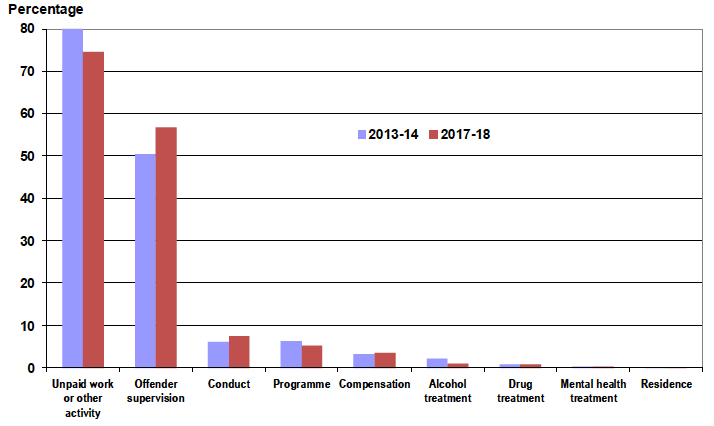
5.2.11 The average number of requirements per order was highest in the first few years after the introduction of the orders. However, it has remained around the same in each of the years 2013-14 to 2017-18, at 1.5 requirements (Tables 10 & 12).
Chart 5: Average age of people getting community payback orders, 2017-18: Breakdown by requirement type
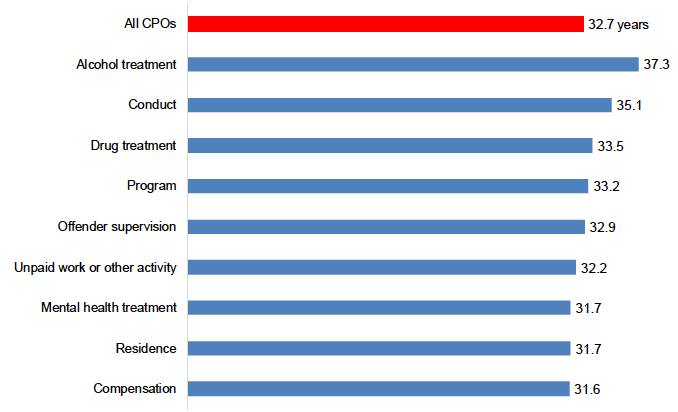
Note: Mean age at the start of the order in complete years
5.2.12 Chart 5 shows how average age varies between people who get different requirement types. The overall cohort of people in receipt of a CPO in 2017-18 was, on average, just under 33 years old. Those who got alcohol treatment requirements were the oldest at over 37 followed by conduct (35) and drug treatment (34). The youngest were those who got a compensation requirement (less than 32). People who got offender supervision were on average around 8½ months older than those who got unpaid work or other activity.
Characteristics
5.2.13 People aged 18 to 20 have always been the most likely to be given a CPO, with 95 people per 10,000 population of this age group given an order in 2017-18. However, people receiving CPOs have been getting slightly older each year. The proportion aged 25 and under has fallen from 38 per cent in 2013-14 to 31 per cent in 2017-18, while those aged over 30 now account for over half of the total (52 per cent) compared with 45 per cent in 2013-14 (Table 10). The fall in the prevalence for young people reflects the marked fall in court volumes for this age group. Chart 6 Illustrates the effect this change has had on the average age of a CPO recipient, which has risen by 2½ years since 2012-13.
Chart 6: Average age of people getting community payback orders, 2012-13 to 2017-18
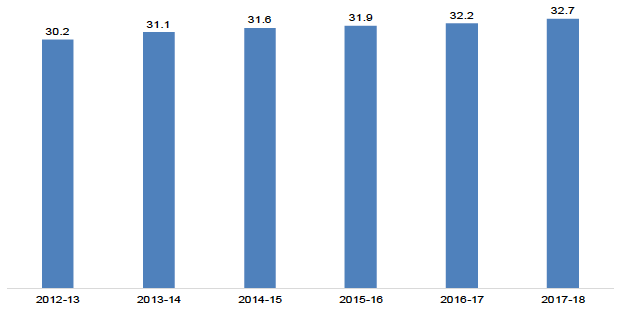
Note: Mean age at the start of the order in complete years. Figure for 2012-13 excludes Aberdeen City, Fife and Moray.
5.2.14 The proportion of orders issued to males has remained unchanged at 85 per cent (Table 10). Generally around 60 per cent of those receiving orders were unemployed with around 20 to 25 per cent in employment or self-employed and around 10 per cent economically inactive.
5.2.15 The vast majority (95 per cent) of community payback orders were issued by sheriff courts in 2017-18, mainly by summary procedure (Table 11). After rising in each of the previous four years, the proportion accounted for by justice of the peace courts fell back to four per cent, around the same level as in 2015-16.
5.2.16 On imposing a community payback order, a court may include provision for the order to be reviewed at specified time(s). Sixteen per cent of orders commenced in 2017-18 were issued with provision for court progress reviews (Table 15). This varied substantially according to the makeup of the order. Orders with unpaid work or other activity (13 per cent) and compensation (17 per cent) were the least likely to have progress reviews. This proportion was high for those with drug (53 per cent) and alcohol treatment (43 per cent) requirements. It was also high for those with a mental health treatment requirement in 2017-18 although this can vary substantially from year to year due to the small numbers involved.
5.2.17 There were a total of 17,600 CPOs in force at 31 March 2018 (see Table 2 and the additional datasets which accompany this publication). After increasing annually as expected due to the gradual phasing out of legacy orders, this number has stabilised over the last three years, falling slightly in the latest year.
Timescales for implementation
5.2.18 The Scottish Government Community payback order practice guidance is intended to support practitioners and managers to improve their performance and work towards the achievement of the national outcomes and standards for social work services in the criminal justice system. The guidance contains a number of principles of best practice, including:
- the first direct contact should take place on the same day as the order is imposed, or the next working day
- where an offender supervision requirement has been imposed, the appointed case manager should arrange to meet the individual within five working days of the date of imposition of the order
- where an unpaid work or other activity requirement has been imposed, arrangements should be made for the individual to begin the induction process within five working days of the date of imposition of the order
- where an unpaid work or other activity requirement is imposed, the work placement should begin within seven working days of the order being imposed.
5.2.19 The proportion of orders where first direct contact took place within one working day of imposition has fluctuated around the 75 to 80 per cent mark over the last five years (Table 16). Around 10 per cent took between two and five working days.
5.2.20 Over the last five years, around 80 per cent of first induction / case management meetings took place within five working days. Roughly equal proportions took six to ten working days and more than ten working days.
5.2.21 There were various reasons why these timescales were not met. Forty-two per cent of delays in first direct contact were due to missed appointments, while the unavailability of a social worker (3 per cent) or other non-client related reason (25 per cent) together accounted for a further 29 per cent (Table 17). Other client-based reasons included being subject to another sentence, employment or illness. Delays for the first induction / case management meeting were due to a wide range of reasons. In 22 per cent of cases the individual missed their induction/meeting, while a further 18 per cent involved being subject to another sentence, employment or illness. Another 17 per cent were due to delays in first making contact or staff availability, with 25 and 18 per cent of cases involving, respectively, other client based and other non-client based reasons.
5.2.22 The proportion of unpaid work placements which started within seven working days rose slightly to 68 per cent in 2017-18, after falling in each of the previous three years from 75 per cent in 2013-14 to 67 per cent in 2016-17 (Table 18). Just over a quarter (27 per cent) of people who started their work placement after seven working days in 2017-18 did so because they did not turn up for the first day of placement (Table 19).
Terminations
5.2.23 The successful completion rate for CPOs terminated in 2017-18 was 70 per cent (Table 2). With the exception of the high level in 2013-14, this rate has generally been around 70 per cent since these orders were introduced. In 2017-18, 18 per cent of orders terminated (excluding those transferred out) were revoked following a breach application to the courts and a further eight per cent were revoked following a review (Table 20).
5.2.24 Almost three-quarters of orders which finished during 2017-18 did not involve any breach applications during the lifetime of the order (Table 21). For the remainder, there were a total of 5,800 breach applications made (Table 22). The vast majority of breach applications (84 per cent) were lodged with the court within five working days of the decision to make an application.
5.2.25 For CPOs revoked due to breach, the most likely specific outcomes were a custodial sentence or a new order (both 26 per cent), with 28 per cent resulting in an “other” outcome (Table 20). Thirteen per cent of orders revoked due to review resulted in a custodial sentence, while 55 per cent had an “other” outcome.
5.2.26 Completion rates in 2017-18 varied by age and employment status (Chart 7). Unlike previous years, which showed a consistent increase with age, the rates were relatively similar for all age groups up to age 40. For this age group as a whole, 67 per cent of orders were successfully completed. For people aged over 40 however, the rate was much higher at 79 per cent. Eighty-four per cent of those who were employed or self-employed completed successfully, compared to 64 per cent of those who were unemployed or economically inactive. Completion rates did not tend to
vary greatly according to how many requirements were in the order, although the success rate was a bit lower for those with four or more requirements
(63 per cent).
Chart 7: Completions/discharges of community payback orders by gender, age, employment status and number of requirements: 2017-18
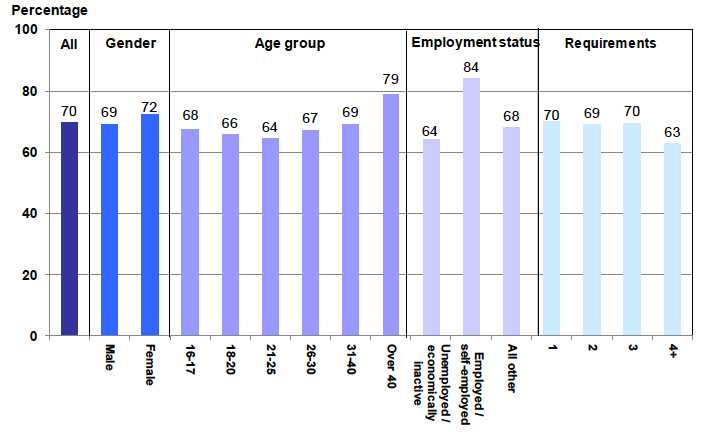
Notes: Age at imposition of order and employment status at termination. The male category includes one order where the person’s gender was classified as “non-specific”.
5.2.27 During 2017-18, a total of 8,900 unpaid work or other activity requirements were successfully completed, nine per cent fewer than in 2016-17 (Table 23). On average, 125 hours were carried out for each order and they took around 7 months to complete.
5.2.28 The Criminal Justice and Licensing (Scotland) Act 2010 defines the time limit for completion of an unpaid work or other activity requirement as "3 months or such longer period as the court may specify in the requirement" for level 1 and "6 months or such longer period as the court may specify in the requirement" for level 2. Thirty-six per cent of successfully completed unpaid work or other activity requirements were completed within the 3/6 month time frame in 2017-18 while a further 38 per cent were completed within a later timescale which the court had specified (Table 24).
5.2.29 For the remaining requirements which were completed outwith the specified timescale, the reason why they were completed later was most commonly down to non-compliance (22 per cent) or other client-based reasons
(34 per cent) in 2017-18.
5.3 Drug treatment and testing orders
Characteristics
5.3.1 The drug treatment and testing order (DTTO) is available to courts (excluding justice of the peace courts) as a high tariff disposal for people with substance use problems who might otherwise get a custodial sentence. In addition, the less intensive DTTO II is available to all courts in City of Edinburgh, East Lothian and Midlothian, and currently accounts for around a fifth of the DTTOs in these areas (see Annex B.6).
5.3.2 The total number of DTTOs imposed fell each year between 2012-13 and 2016-17, before rising to 570 in 2017-18, the highest level since 2013-14 (Tables 2 & 25 and Chart 8).
Chart 8: Drug treatment and testing order commencements, terminations and completions/discharges: 2012-13 to 2017-18
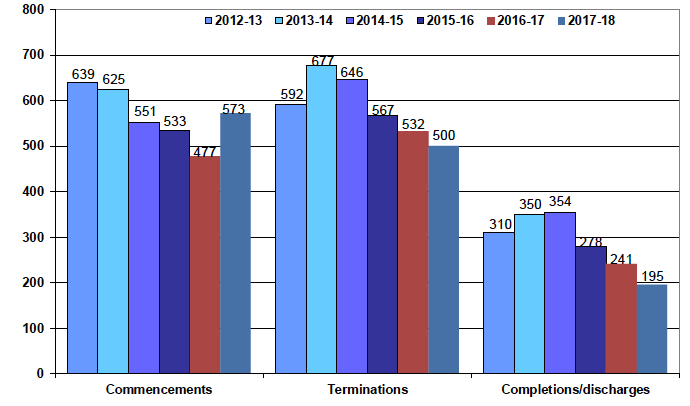
5.3.3 In 2017-18, there were 1.5 DTTOs imposed per 10,000 population (Table 3). This was highest for residents of West Dunbartonshire (4.1), City of Edinburgh (4.0) and Fife (2.7). More information by local authority area can be found in the additional datasets which accompany this publication.
5.3.4 Over the last five years, people aged 31 to 40 have been the most likely to receive a DTTO (just over 4 per 10,000 population in 2017-18). It has consistently been those aged under 21 and those aged over 40 who have been the least likely (0.2 and 0.5, respectively, per 10,000 population in 2017-18).
5.3.5 The proportion of orders issued to males has been around 80 per cent over the last five years (Table 25). A very high proportion (generally between 85 and 90 per cent) of those receiving a DTTO are unemployed or economically inactive.
5.3.6 The average length of a DTTO has been around 18 months over the last five years (Table 25).
5.3.7 There were 580 DTTOs in force on 31 March 2018, a rise of 14 per cent from the previous year (Table 2).
Timescales for implementation
5.3.8 The proportion of DTTOs which had first direct contact within one working day of the order being imposed has fallen in each of the last two years, reaching 68 per cent in 2017-18 (Table 26), although the small number of orders involved mean there are inevitable year on year fluctuations.
5.3.9 Over the last four years, the proportion of orders where the first case management meeting took place within five working days was consistent at around 83 to 84 per cent (Table 26). In around 9 per cent of cases, it took longer than ten working days for the first meeting to take place.
5.3.10 The reasons provided for not meeting these timescales in 2017-18 suggest that people receiving DTTOs have difficulty complying, as not attending meetings without an excuse is very prevalent, particularly for case management meetings (63 per cent) (Table 27).
Terminations
5.3.11 The percentage of orders successfully completed tends to be lower for DTTOs than for other social work orders, due to the complex needs of those involved.
5.3.12 Between 2016-17 and 2017-18, the completion rate for DTTOs terminated fell from 46 per cent to its lowest level in the last seven years of 40 per cent (Table 2). Alongside this, the proportion of orders revoked due to review increased substantially from 27 per cent in 2016-17 to a historic high of 38 per cent in 2017-18. This may have been a contributory factor to the fall in the completion rate over this period. A further 18 per cent of orders in 2017-18 were revoked due to breach, around the same proportion as in previous years (Table 28). A custodial sentence was imposed in 54 per cent of revoked cases in 2017-18 (Table 29).
5.3.13 Sixty-eight per cent of orders were terminated without breach applications (Table 30). The vast majority (83 per cent) of the breach applications were lodged with the court within 5 working days of the decision being made to make an application (see the additional datasets which accompany this publication).
5.3.14 Completion rates in 2017-18 varied noticeably by age (Chart 9), with older people being more likely to complete. The rate for those aged over 40 (63 per cent) was more than double the rate for 26-30 year olds (30 per cent).
Chart 9: Completions/discharges of drug treatment and testing orders by gender and age: 2017-18
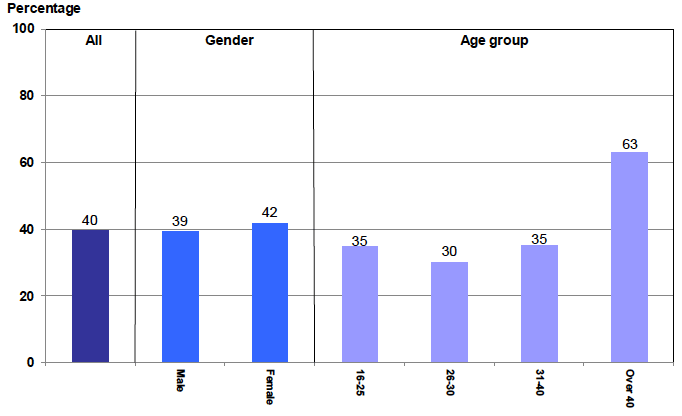
Notes: Age at imposition of order.
Longitudinal analysis
5.3.15 Table 31 shows results from a longitudinal analysis of the DTTO data. All of the orders imposed during the years 2012-13 to 2015-16 have now finished and this analysis mainly looks at completion rates by various factors for the cohorts of orders commenced in those years. For each year, while most orders were for over a year and up to 18 months in length, the completion rate was highest for orders of up to a year and lowest for those of over 18 months.
5.3.16 For orders commenced in each of 2012-13 to 2014-15, the success rate was substantially higher for DTTO IIs than for full DTTOs. However, this pattern changed among orders which started in 2015-16, when the rate for DTTOs fell sharply to 40 per cent, compared with 45 per cent for full DTTOs.
5.3.17 Unsurprisingly, whether there are breach application(s) during the course of an order is a major indicator of whether the order is likely to be successfully completed. Almost 70 per cent of orders which started in 2015-16 and which had no breach applications, were successfully completed. This compared with only 7 per cent of orders where there was at least one breach application.
5.4 Fiscal work orders
5.4.1 Fiscal work orders (FWOs) were introduced nationally on 1 April 2015 and allow Procurators Fiscal to offer unpaid work orders as an alternative to prosecution. They can be for a minimum of 10 and a maximum of 50 hours and should be completed within six months.
5.4.2 Prior to their introduction nationally, fiscal work orders were piloted in four council areas from June 2008 and in a further three areas from early 2011.
5.4.3 The number of FWOs in Scotland have increased each year since their introduction nationally in 2015-16. During 2017-18, there were 1,400 fiscal work order assessments undertaken by local authorities, 1,060 of which resulted in the orders being accepted (Table 32). There were 1,030 orders commenced in 2017-18, more than double the number in 2015-16. Just under 1,000 orders finished during 2017-18, 86 per cent of which were successfully completed.
5.4.4 People given fiscal work orders tended to be younger than those given community payback orders. Fifty-eight per cent of FWOs commenced in 2017-18 were for people aged 25 and under, while only 12 per cent were for those aged over 40 (Table 33). Unlike other orders, more people were employed or self-employed (53 per cent) than any other category of employment. Twenty-eight per cent were either unemployed or economically inactive.
5.4.5 More than half (53 per cent) of orders imposed in 2017-18 were for 30 hours. A further quarter were for 40 hours with one-sixth for 50 hours. The average length of order remained around 35 hours in 2017-18, the same as in 2016-17, after rising from 32 hours in 2015-16.
There is a problem
Thanks for your feedback